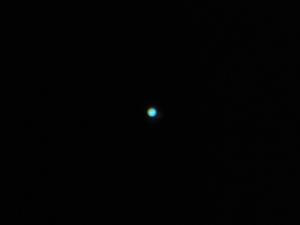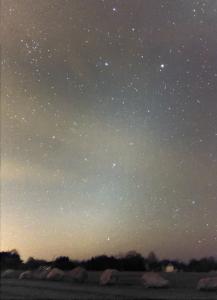
Public Stargazing - Rhythm and Roots 2014
- Where:
- Frosty Drew Observatory
- When:
- Friday August 29, 2014 at 6:00 p.m.
- Cost:
- $1 Suggested Donation per Person
This weekend the annual Rhythm and Roots music festival returns to Ninigret Park. With the festival comes excellent tunes, lively people, and all night stargazing. The music festival will also open Frosty Drew Observatory on both Friday night and Saturday night this weekend. We usually stay open all night long and will have our first views of the Orion Nebula, the Crab Nebula and Jupiter. Though the festival brings an excellent time to Frosty Drew Observatory, it will also bring loud music, a very large and lively crowd, limited parking, and a slight increase in light pollution. With the increased numbers in the park, the Nature Center and Sky Theatre will remain closed tonight, but the Observatory will be in full swing rock out mode!
Tonight's forecast is calling for mostly clear to partly cloudy skies. The super thin 17% waxing crescent Moon will set early at 9:12 p.m. offering us spectacular twilight views of the thin crescent phase. Once the Moon sets, dark skies will prevail setting us up for excellent viewing of Saturn, star clusters, nebulae, Comet Jacques, Neptune, Uranus, and Jupiter. We will open tonight at 6:00 p.m. with views of the Sun and any sunspots visible on the solar photosphere. Once the Sun sets we will direct our telescopes to the night sky. The 16” observatory telescope will start off the night with the crescent Moon then Saturn. Once Saturn descends to the Western horizon, we will point the telescope towards the center of the Milky Way galaxy. Telescopes in the court yard will be available until near midnight showcasing a host of celestial objects including binary stars, clusters, the Andromeda Galaxy, and Comet Jacques.
Tonight is our last night of sun-spotting for the 2014 summer season. So be sure to stop in a catch a glimpse of the sunspots 2149, 2151, and 2150 this afternoon. Otherwise, stop in for a crazy night of awesome music, crazy people, and the best stargazing bucket list of the Summer!
-------------------------------------------------------------------------
Weekly Happenings
Scott MacNeill
At the Observatory we almost always showcase a planet at the start of our viewing sessions. The planets are easy to see and usually offer a higher level of detail compared to some of the dimmer objects we observe. The best time to view planets are just before, on and after their oppositions. Opposition occurs when the planet is on the opposite side of Earth than the Sun. This can also be called an alignment as the Sun, Earth, and the planet in question all form a straight line. Consequently, during opposition the planet is at its closest point to Earth for the year (in most cases). Well this morning was Neptune's big moment. At 10:18 a.m. EDT today Neptune reached opposition, which will make for excellent viewing of Neptune tonight.
Neptune is the fourth largest planet in the Solar System and the eighth and furthest planet from the Sun. At a distance this morning of 2.7 billion miles, it takes light 4 hours to reach Earth at the speed of light. Being so far from the Sun, it takes Neptune 165 Earth years to make one full orbit around the Sun. Neptune has an equatorial circumference of 96,129 miles (compared to Earth's 24,873 miles), and can fit 57 Earths into its volume. Neptune's atmosphere is comprised mostly of hydrogen, helium, and methane with the abundance of methane giving it that bright blue-green hue that it is so known for. Unlike many of the planets, Neptune is so far out there that naked eye visibility is impossible. Even in binoculars Neptune would be difficult to see. When viewing through a big aperture telescope with a slow focal ratio, Neptune will show off striking colors and possibly a moon or two. Check out the program Stellarium to find a precise location of Neptune as seen from your viewing site, then grab your telescope and head out for a view. If you don't have a telescope, visit a local observatory to catch a peek at the furthest of the gas giants while the view rocks!
Ever hear of a celestial phenomenon known as “Zodiacal Light”? Well if you haven't, don't feel late to the party, as the majority of New England residents have likely overlooked it as well. Zodiacal Light, also known as “False Dawn” is a cone of light that extends upward from the Eastern or Western horizon that follows the ecliptic (the path the Sun takes across the sky). Zodiacal Light is most visible in the Eastern sky around the Autumnal Equinox just before pre-dawn and in the Western sky around the Vernal Equinox just after twilight. Zodiacal Light is caused by sunlight reflecting off of a collection of dust and tiny debris left behind by asteroid collisions and passing comets. This dust and debris forms along the plane of the Solar System and is called the Zodiacal Cloud. Light pollution is the number one reason why Zodiacal Light is not visible to many of us in New England, but natural occurrences will also obscure our view of Zodiacal Light, like bright moon light. Last year Zodiacal Light made two appearances at Frosty Drew. The first showing was in November 2013 in the Eastern morning sky and then again in March 2014 appearing in the Western night time sky. Now that we are inside a months time from the Autumnal Equinox, Zodiacal Light sightings at Frosty Drew are primed to begin. Stop in at Frosty Drew early on a Saturday morning (between 4:00 a.m. and 5:00 a.m.) when the Moon is well below the horizon and try to spot the fabled Zodiacal Light with us!
-Scott


